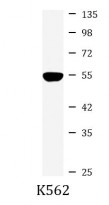ARG42877
anti-KATNA1 / p60 katanin antibody
anti-KATNA1 / p60 katanin antibody for ICC/IF,Western blot and Human
Overview
| Product Description | Rabbit Polyclonal antibody recognizes KATNA1 / p60 katanin |
|---|---|
| Tested Reactivity | Hu |
| Tested Application | ICC/IF, WB |
| Host | Rabbit |
| Clonality | Polyclonal |
| Isotype | IgG |
| Target Name | KATNA1 / p60 katanin |
| Antigen Species | Human |
| Immunogen | Synthetic peptide of Human KATNA1 / p60 katanin. |
| Conjugation | Un-conjugated |
| Alternate Names | EC 3.6.4.3; Katanin p60 ATPase-containing subunit A1; Katanin p60 subunit A1; p60 katanin |
Application Instructions
| Application Suggestion |
|
||||||
|---|---|---|---|---|---|---|---|
| Application Note | * The dilutions indicate recommended starting dilutions and the optimal dilutions or concentrations should be determined by the scientist. | ||||||
| Positive Control | K562 | ||||||
| Observed Size | ~ 55 kDa |
Properties
| Form | Liquid |
|---|---|
| Purification | Affinity purified. |
| Buffer | 50 mM Tris-Glycine (pH 7.4), 150 mM NaCl, 0.01% Sodium azide, 40% Glycerol and 0.05% BSA. |
| Preservative | 0.01% Sodium azide |
| Stabilizer | 40% Glycerol and 0.05% BSA |
| Concentration | Batch dependent |
| Storage Instruction | For continuous use, store undiluted antibody at 2-8°C for up to a week. For long-term storage, aliquot and store at -20°C. Storage in frost free freezers is not recommended. Avoid repeated freeze/thaw cycles. Suggest spin the vial prior to opening. The antibody solution should be gently mixed before use. |
| Note | For laboratory research only, not for drug, diagnostic or other use. |
Bioinformation
| Database Links |
Swiss-port # O75449 Human Katanin p60 ATPase-containing subunit A1 |
|---|---|
| Gene Symbol | KATNA1 |
| Gene Full Name | katanin p60 (ATPase containing) subunit A 1 |
| Background | Microtubules, polymers of alpha and beta tubulin subunits, form the mitotic spindle of a dividing cell and help to organize membranous organelles during interphase. Katanin is a heterodimer that consists of a 60 kDa ATPase (p60 subunit A 1) and an 80 kDa accessory protein (p80 subunit B 1). The p60 subunit acts to sever and disassemble microtubules, while the p80 subunit targets the enzyme to the centrosome. This gene encodes the p80 subunit. This protein is a member of the AAA family of ATPases. Multiple alternatively spliced variants, encoding the same protein, have been identified. [provided by RefSeq, Feb 2011] |
| Function | Catalytic subunit of a complex which severs microtubules in an ATP-dependent manner. Microtubule severing may promote rapid reorganization of cellular microtubule arrays and the release of microtubules from the centrosome following nucleation. Microtubule release from the mitotic spindle poles may allow depolymerization of the microtubule end proximal to the spindle pole, leading to poleward microtubule flux and poleward motion of chromosome. Microtubule release within the cell body of neurons may be required for their transport into neuronal processes by microtubule-dependent motor proteins. This transport is required for axonal growth. [UniProt] |
| Cellular Localization | Cytoplasm. Midbody. Cytoplasm, cytoskeleton, microtubule organizing center, centrosome. Cytoplasm, cytoskeleton, spindle pole. Cytoplasm, cytoskeleton, spindle. Note=Predominantly cytoplasmic. Localized diffusely in the cytoplasm during the interphase. During metaphase is localized throughout the cell and more widely dispersed than the microtubules. In anaphase and telophase is localized at the midbody region. [UniProt] |
| Calculated MW | 56 kDa |
| PTM | Phosphorylation by DYRK2 triggers ubiquitination and subsequent degradation. Ubiquitinated by the BCR(KLHL42) E3 ubiquitin ligase complex, leading to its proteasomal degradation. Ubiquitinated by the EDVP E3 ligase complex and subsequently targeted for proteasomal degradation. [UniProt] |
Images (1) Click the Picture to Zoom In






